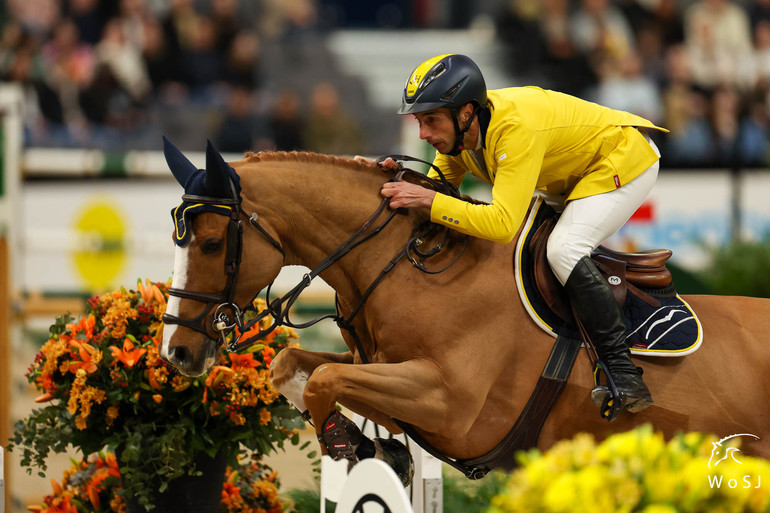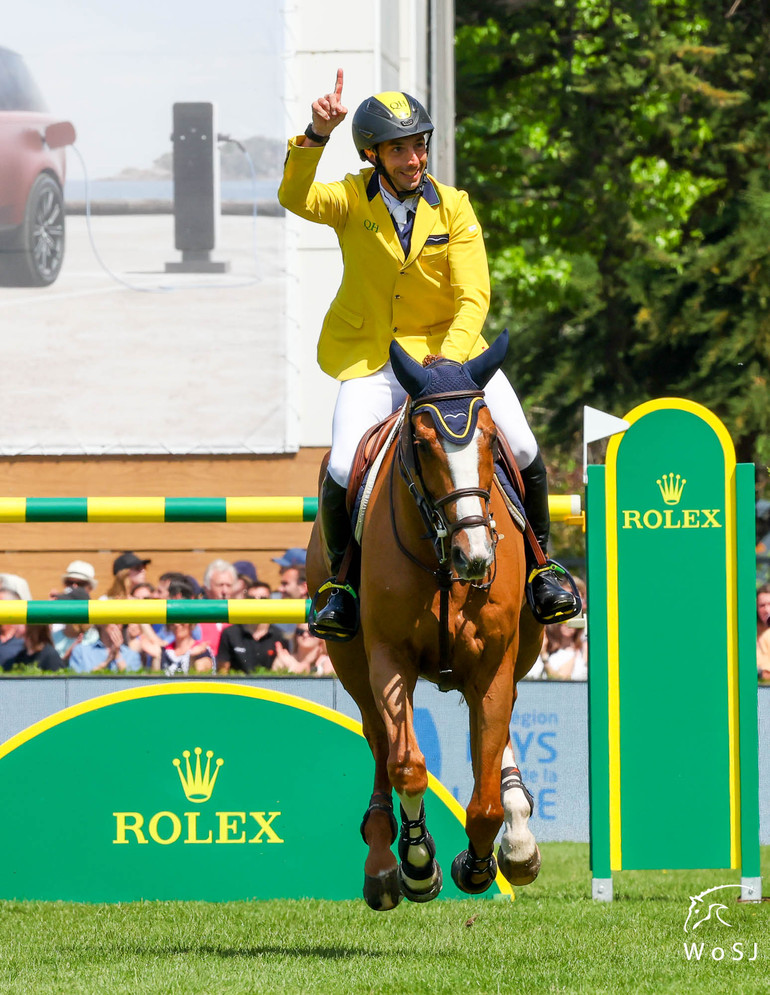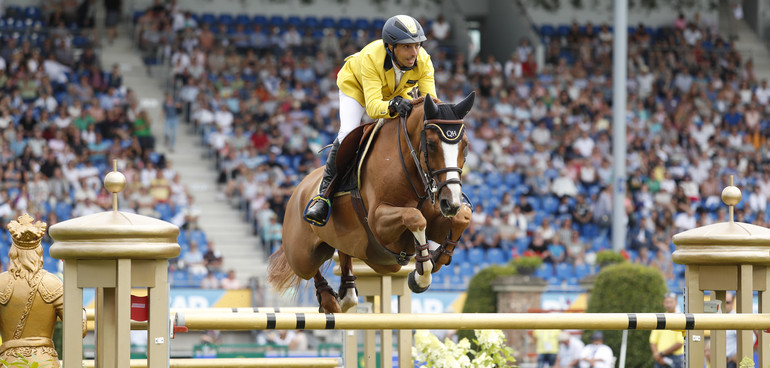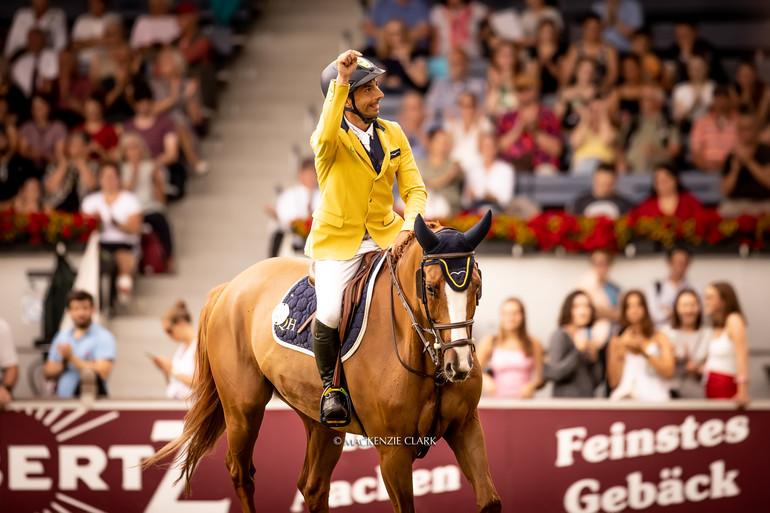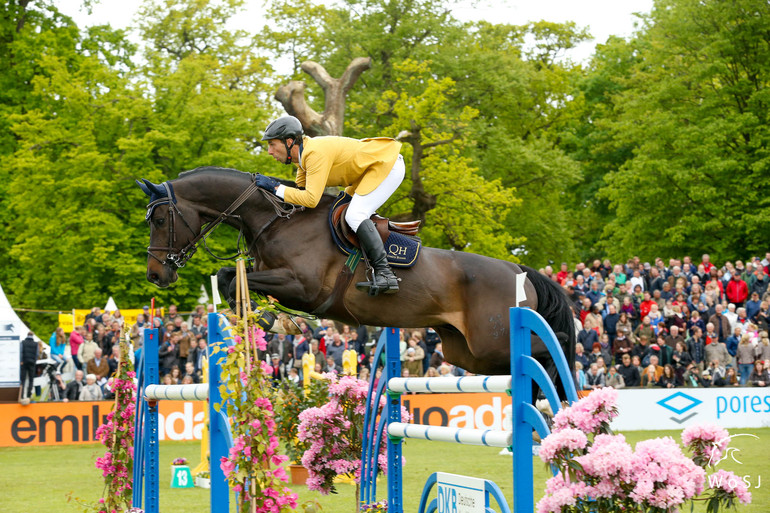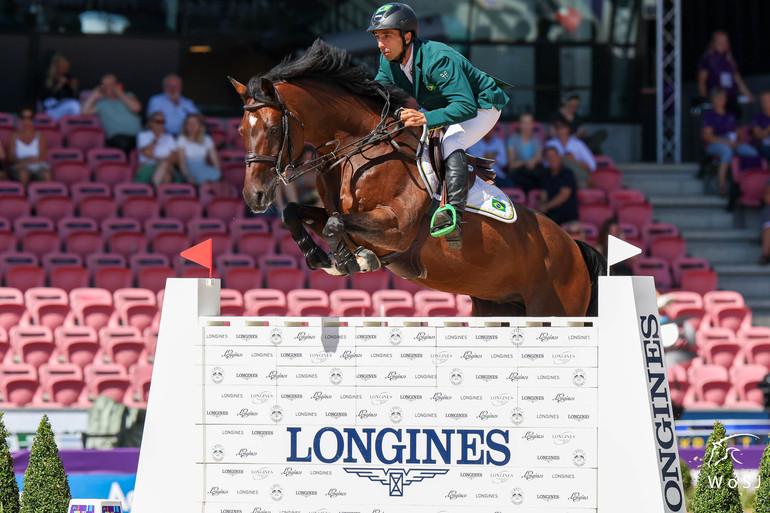Text © World of Showjumping
In our series ‘That Special Bond’, we highlight what this sport truly is about; the unique connection between horses and humans. Speaking with some of the top names in the sport, we learn more about the horses that have shaped careers, fulfilled dreams – and sometimes even broken hearts. In Yuri Mansur’s case, it is one horse that has done all of the above – Vitiki (Valentino 240 x For Expo).
The special one
“The most special horse I have had during my career is for sure Vitiki,” Yuri says of the now 15-year-old gelding. “Not only because of all we went through together, but also because that from the first jump I made with him I believed in him. I had a special connection with him from the beginning, which over time got even stronger and he is probably also one of the best horses I ever rode. If I could describe my perfect horse, it would be very close to what he is.”
Vitiki’s life story is unbelievable
“Vitiki’s life story is unbelievable,” Yuri says. “Five days after I bought him, the police showed up at my barn and took him away because the guy I had acquired him from was not the actual owner. As a consequence, the police seized Vitiki and I had to go to court to get him back. I did not want my money back though, all I wanted was him – and I think it took around a month before he finally returned to my barn. This was in October 2017, he was nine at the time, and at this point the biggest he had jumped was a 1.35m. A little over half-a-year later, in May 2018, he was clear and had one down in the CSIO5* Nations Cup in La Baule where Brazil won. One month later, he was clear in the Prize of Europe in Aachen.”
“But then, during the second round of the Prize of Europe in Aachen, Vitiki had an accident, and he broke his leg,” Yuri tells about their horrible fall that had dramatic consequences. “I promise, I already had hard days in my life but that was for sure the hardest of them. Because I had hit my head quite hard, I had to go to see a doctor, so I was a bit late arriving for Vitiki who was with the vet. One of my best friends, who also is a vet, was already there and I could see him looking at the x-rays and crying. In that moment, I was on my knees, how could something like this be possible? The three years that followed were really tough. I’m not a person that gets easily down, but I was no longer the same as I used to be – I lost a bit my confidence, and I lost the pleasure to ride.”
“However, from this moment something very important also happened – because this is when I started to create this really special connection with Vitiki,” Yuri tells. “At the end of the day, our sport is about connection, and we think we have connection – but with this horse it became unbelievable, not only for me, but also for my family. What my two kids learned from the process with Vitiki was invaluable; witnessing that no matter how difficult something is, if you believe and work hard enough, anything is possible.”
At the end of the day, our sport is about connection
“The first year of Vitiki’s recuperation, everyone asked me why I was even trying,” Yuri tells. “Today it is a beautiful story, but if something would have gone wrong in the process of bringing him back, I would also have been considered a monster for trying. So, it was a lot of pressure and a lot of stress involved. My obsession for him coming back was perhaps connected to myself as well, I felt like if he would not come back, I would not either,” Yuri explains.
“After his surgery in July 2018, Vitiki spent six months in the box. The first 45 days, he had his leg in a cast,” Yuri tells. “When I think about it, I still remember the feeling of how difficult it was. First of all, it was terrible with the cast – he still has a scar from it. Secondly, there were many different professional opinions on how the surgery had been done, how the screws in his legs had been positioned and, of course, I started questioning when everyone else did. Eventually, the miracle of the surgery turned out to be how Dr. Jack Snyder had positioned the screws – one of them he put really, really close to the joint. However, removing the screws meant another surgery – which also was risky, but in the end, we decided to do it.”
“It took a long time for the fracture to close, but I had a gut feeling that Vitiki still had to move – his body was really not good; his back was weak, his belly was down, he was very stiff everywhere,” Yuri tells. “I still remember the first time I trotted him – it was terrible – he was trotting really, really, short, and then, just as he began moving there was this huge sound of ‘clack’ and I thought to myself ‘oh my god, what was that?’ But after, he felt much better – as if something fell into place.”
I followed my feeling
“By April 2019 he was back in work. Then in late June, I decided to make a little jump with him. My brother was there, and he was so scared that something would happen to me that he decided to make the jump with Vitiki himself. He completely missed and I thought to myself ‘If Vitiki survives this, he’ll be fine!’ Slowly, I started him over small fences. There were days where he did not feel great after jumping, but I decided to keep going but without forcing anything – supporting him in whatever way I felt was right. He never trotted great for the vet though, and I have to admit there were times my vet was angry with me and was of the opinion that I was crossing a line. However, I followed my feeling. Then, in September, I took Vitiki to St. Tropez to jump a few 1.20 classes and he was amazing. From there, things started to fall into place.”
“In 2020, I took Vitiki to Wellington – and we had many ups and downs,” Yuri tells. “Then Covid struck, we went back home, and he just did not feel like the same horse he used to be – he did not have the same scope, he was much hotter than he had been, he jumped a lot to the left... But, at the end of that year, he was third in the first Grand Prix in Vilamoura – and from there on it got better. While he was not my horse for the Tokyo Olympics, he was so important in my qualification process because my main horse was out with a hoof crack. Step by step, my confidence came back to me.”
“In 2021, I again brought him to Wellington and there he did his first five-star Grand Prix after his accident.,” Yuri tells. “I don’t know why, but I was really worried about jumping the open water with him – especially with the special shoes we had put on him. I thought to myself ‘if I don’t have the perfect distance, I do a circle and retire.’ But I had a good distance, jumped it clear and finished with one down. In the last five-star Grand Prix in Wellington in 2021, he jumped the only clear for Brazil – and that was a really emotional moment for everyone at my barn. From there on, I felt we were back."
I had to really analyse what was going on and face my problems
“When I went back to Aachen with him in the autumn of 2021, I tried to be cold,” Yuri tells. “In the Nations Cup, I had two down in the first round and one down in the second, but I could feel he did not have the same stride as before. In the Grand Prix, there was a line of four long strides; I did not see the four, stopped him in front of the fence and retired. That was so hard, all the confidence I had gained after our accident, I lost in that round. Four weeks later, I had the same situation happen in Samorin. I had to really analyse what was going on and face my problems. Eventually, I figured out that he jumped a lot to the left at that time, landed short and that his stride was smaller than I thought."
“More set-backs followed,” Yuri tells. “We discovered a tumour in Vitki’s nose that had to be removed. It was a terrible surgery, and he needed three months of recovery. However, not long after, in La Baule in 2022, he was second in the Grand Prix. He was still not perfect, but the process from there to where we are now really brought him to where he should be.”
“Then in 2022, four years after our accident, we again returned to Aachen and jumped clear in the Prize of Europe. It was magic. I cried then, and even now…,” Yuri says as tears stream down his face.
“The process of bringing Vitiki back was crazy, but I learned so many things. As an example, last year, he lost a shoe – I panicked, these are really special shoes and my blacksmith was on holiday,” Yuri explains. “Because the shoes were so different, I decided to take the second one off, and out of curiosity I trotted him without shoes. He felt really good. I ended up riding him one week without shoes – and it was so good for the shape of his hooves. I then tried with a normal shoe, but he did not like it, so I put back the special shoes – and after that he was unbelievable. Now, he is the soundest horse of the whole stables.”
The process of bringing Vitiki back was crazy, but I learned so many things
“The day that Vitiki got injured was for sure the hardest day of my life, but I also would not have wished to have been without it because I learned so much – as a rider, as a horseman, as a person, for my family too and especially for my kids,” Yuri tells – visibly emotional. “I always knew I was tough; I had a lot of challenges throughout my life, but what Vitiki taught me is that we speak about belief, dreams and hope and that normally when you work hard you can make a process quicker. If a process gets long, and it takes time to get to where you want to, humans often tend to change direction. But because of Vitiki I learned that time and patience is everything, and so is keeping your direction. With horses, you have to respect time.”
“I have had offers on Vitiki, you cannot imagine,” Yuri tells. “But at the end of the day, I could never sell him – how could I explain that to my kids after what he brought to our family? How do you explain putting a value on a life like his. He will never be sold. No chance.”
The money makers
“First Devision (Andiamo x Perhaps vh Molenvondel) and Cornetto K (Cornet Obolensky x Calido I) changed my life completely. For First Devision, the goal was to resell, but Cornetto K I bought to keep,” Yuri tells.
As a rider you improve in this process
“I bought First Devision when he was seven from Harrie Smolders, and sold him to Qatar when he was ten after having brought him up to five-star Grand Prix level. I took the money I made and invested it in Cornetto. It was a considerable amount at the time, and a year later I had offers I could not refuse so I sold him. It was hard, but I had to be realistic. I missed the Olympics in Rio, and he went with Doda de Miranda instead. But, it was the right decision and I would have made it again. Selling him made it easier for me financially and I could breathe again. At the time it was hard though, and although I got a lot of money, I cried a lot too,” Yuri continues.
“It is always hard to sell the horses, but I also think that as riders we can prove a lot to ourselves when we can find another one, build up again, and repeat. As a rider you improve in this process, you get better and you learn from each horse,” Yuri says.
Hardest to get to know
“QH Alfons Santo Antonio (Aromats x False Pass) has definitely been the most difficult to get to know, but in the end my relationship with him in the ring has become incredible,” Yuri tells about the 16-year-old gelding. “Alfons came to me from Estonia, where he had been competed by Rein Pill. Alfons was a stallion until he was eight, began his career quite late and had a hard character – and a lot of the time, I felt that he was against me. His canter was really difficult, he did not want to connect to me – but he could jump fantastic when I found a way to not disturb him.”
A lot of the time, I felt that he was against me
“Alfons’ results were so up and down, and for a long time I could not find a way to make him consistent – he would have three down in the Grand Prix in Opglabbeek, then be clear in the World Cup in Stuttgart a few weeks after. He kept on making mistakes in the ring, and also did not really improve in his flatwork. He gave me a real headache,” Yuri tells.
“I love to run; and that’s when I came up with this idea that became the start of making him change,” Yuri tells. “One day, while I was on the treadmill at quite a high speed, I suddenly lost my balance, and I grabbed the bar in front of the machine. In that moment I thought of Alfons; because he did not want contact, he had no balance and he would get upset. I went straight back to the stable, tried a straight snaffle and felt ‘wow’. That was our A, on our way to Z and from there on the flatwork got better.”
“At one point, back at the beginning of 2021, in my attempt to improve Alfons in the ring, I tried a hackamore, a shorter martingale and took off the hind boots. He felt a little better, but I did not like the hackamore. A few weeks from there, I was supposed to do a Nations Cup – our first Olympic selection competition and I still did not have a good solution for him. I decided to drop the hackamore, and go back to my previous bridle."
It all comes down to my obsession of finding a way
"I took him to a training show, and as I warmed up over the cross-poles he was jumping over the wings. I could not understand, and to start with I thought he jumped like this because he was on grass," Yuri continues. "Then at his next show, he jumped clear in the 1.50m qualifier and then double clear in the Grand Prix. In the end, the secret was that I had forgotten to lengthen the martingale after I had it with the hackamore and this helped me get the contact he did not give me. From there on, he was amazing. We jumped double clear in the Nations Cup in Rome and La Baule, were selected for the Olympic Games in Tokyo and the year after for the World Championship in Herning – forming a fantastic partnership.”
“In the end, it all comes down to my obsession of finding a way, no matter how difficult it might be. Alfons has ended up realising many of my big dreams, like jumping at the Olympic Games,” Yuri smiles.
The one that got away
“I almost don’t want to say it – it is Toveks Mary Lou (Montendro x Portland L),” Yuri laughs while shaking his head. “I was offered the mare through a Dutch dealer, but for no particular reason I was a bit slow to go and try her. Then Karl Schneider bought the horse, Henrik von Eckermann got the ride, and the rest is history! Mary Lou went on to win some of the biggest Grand Prix classes and Nations Cups in the world with Henrik, as well as team silver at the World Equestrian Games in Tryon in 2018 as well as at the European Championships in Gothenburg in 2017. Needless to say, I have had big regrets about being too slow, and not getting there before Karl,” Yuri smiles.
7.3.2023 No reproduction of any of the content in this article will be accepted without a written permission, all rights reserved © World of Showjumping.com. If copyright violations occur, a penalty fee will apply.



